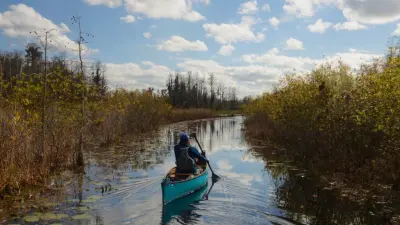Georgia environmentalists are still celebrating a conservation group’s announcement last month that it plans to purchase thousands of acres of land targeted for mining near the Okefenokee National Wildlife Refuge.

But they read the win, they say, not as a moment to pop the champagne, but a call to action.
Mining interests are still eyeing property near the refuge, they say, and to preserve additional acreage, they need to build on their advocacy efforts, including persuading environmental groups to buy mineral rights in other areas attractive to mining businesses and highlighting easements for purchase along mineral-rich Trail Ridge.
And they say they need to continue to press Georgia leaders to enact the legal protections for the Okefenokee that have eluded them for years at the state Capitol. Lawmakers will return to Atlanta for a new legislative session in January.
“We can’t rest on our laurels,” said Brian Foster, a spokesman for Georgia Conservancy, one of the environmental groups leading the charge. “There is still a lot of work to be done.”
There’s a reason for their urgency, Georgia environmentalists said.
In the late 1990s, the environmental community thought the Okefenokee was safe from mining after chemical giant DuPont was persuaded to donate thousands of acres to The Conservation Fund because of public opposition to DuPont’s mining plans.
Three decades later, Alabama-based Twin Pines Minerals, which has owned land along Trial Ridge since 2019, appeared close this year to realizing its plans to mine the area for titanium dioxide, a whitening agent in toothpaste, paint, sunscreen and other products.
But The Conservation Fund, a nonprofit based in Arlington, Virginia, stepped in again, announcing late last month that it would spend almost $60 million to purchase close to 8,000 acres owned by Twin Pines.
Environmentalists were elated, but quickly turned their attention to protecting land that could still be purchased for mining.
“If there is one thing that is abundantly clear to us is that the past is prologue when it comes to the Okefenokee,” said Christian Hunt, chairman of the Okefenokee Protection Alliance.
“Roughly 25 years ago we were pretty much in the same position we’re in today,” said Hunt, who also is director of national wildlife refuges and parks program for Defenders of Wildlife. “It’s very clear to everybody involved at this stage that goodwill alone is not going to save the swamp and we need to secure durable protections.”
Environment Georgia launched a campaign to collect 10,000 signatures calling on Gov. Brian Kemp to pursue permanent protections for the Okefenokee just days after The Conservation Fund’s announcement. The organization hopes to meet its goal by the end of the summer.
“We know that there are mineral rights that are still in the hands of people who could and would like to use them, so we would like to make sure that we find a permanent protection that ensures that there is not another mine proposed,” Environment Georgia Director Jennette Gayer said.
“Our hope is that we do not find ourselves in the same position a couple of decades from now,” she said.
Kim Bednarek, executive director of Okefenokee Swamp Park and Adventures, said environmentalists are not the only ones concerned about the refuge. It has a direct impact on the economies of Charlton, Ware and Clinch counties, which are home to the majority of the Okefenokee’s shallow, 438,000-acre, peat-filled wetland along the Georgia-Florida border.
A healthy Okefenokee promotes agritourism in the three small south Georgia counties, which have a combined population of about 54,000 people, as well creating jobs and encouraging workforce development, she said.
In addition, the Okefenokee National Wildlife Refuge has been nominated to be a UNESCO World Heritage Site, which could further boost its visitation numbers, Bednarek said. A decision on the nomination is expected next year.
More than 800,000 people visit the Okefenokee annually, according to Okefenokee Swamp Park and Adventures. Visitors spend about $91.5 million in Ware, Charlton, and Clinch counties.
“It’s really a huge opportunity for the region and the gateway communities around the Okefenokee to benefit from increased tourism and educational and research activities,” Bednarek said. “We want to see more sustained attention and investment in the communities and the people around the Okefenokee. If the people are benefitting from a conserved landscape, then they’ll want to make sure the landscape stays preserved.”
Megan Huynh, senior attorney and wetlands and coasts program leader for the Southern Environmental Law Center, echoed Bednarek.
“Now that the mine is gone, there’s a responsibility to support opportunities for those communities that aren’t at odds with the health of the Okefenokee,” she said.
Mike Worley, president and CEO of the Georgia Wildlife Federation, said the goal is to use every available tool to ensure the future of the Okefenokee.
“The main thing right now is to celebrate the victory that we’ve had and be prepared to finish the job,” he said.







